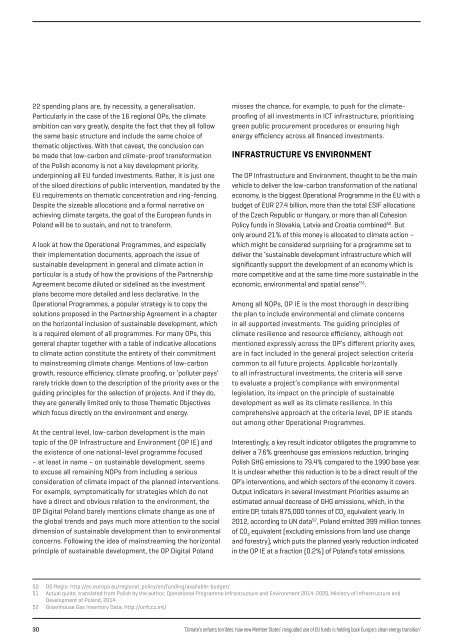ENFANTS TERRIBLES
enfants-terribles
enfants-terribles
Create successful ePaper yourself
Turn your PDF publications into a flip-book with our unique Google optimized e-Paper software.
22 spending plans are, by necessity, a generalisation.<br />
Particularly in the case of the 16 regional OPs, the climate<br />
ambition can vary greatly, despite the fact that they all follow<br />
the same basic structure and include the same choice of<br />
thematic objectives. With that caveat, the conclusion can<br />
be made that low-carbon and climate-proof transformation<br />
of the Polish economy is not a key development priority,<br />
underpinning all EU funded investments. Rather, it is just one<br />
of the siloed directions of public intervention, mandated by the<br />
EU requirements on thematic concentration and ring-fencing.<br />
Despite the sizeable allocations and a formal narrative on<br />
achieving climate targets, the goal of the European funds in<br />
Poland will be to sustain, and not to transform.<br />
A look at how the Operational Programmes, and especially<br />
their implementation documents, approach the issue of<br />
sustainable development in general and climate action in<br />
particular is a study of how the provisions of the Partnership<br />
Agreement become diluted or sidelined as the investment<br />
plans become more detailed and less declarative. In the<br />
Operational Programmes, a popular strategy is to copy the<br />
solutions proposed in the Partnership Agreement in a chapter<br />
on the horizontal inclusion of sustainable development, which<br />
is a required element of all programmes. For many OPs, this<br />
general chapter together with a table of indicative allocations<br />
to climate action constitute the entirety of their commitment<br />
to mainstreaming climate change. Mentions of low-carbon<br />
growth, resource efficiency, climate proofing, or ‘polluter pays’<br />
rarely trickle down to the description of the priority axes or the<br />
guiding principles for the selection of projects. And if they do,<br />
they are generally limited only to those Thematic Objectives<br />
which focus directly on the environment and energy.<br />
At the central level, low-carbon development is the main<br />
topic of the OP Infrastructure and Environment (OP IE) and<br />
the existence of one national-level programme focused<br />
– at least in name – on sustainable development, seems<br />
to excuse all remaining NOPs from including a serious<br />
consideration of climate impact of the planned interventions.<br />
For example, symptomatically for strategies which do not<br />
have a direct and obvious relation to the environment, the<br />
OP Digital Poland barely mentions climate change as one of<br />
the global trends and pays much more attention to the social<br />
dimension of sustainable development than to environmental<br />
concerns. Following the idea of mainstreaming the horizontal<br />
principle of sustainable development, the OP Digital Poland<br />
misses the chance, for example, to push for the climateproofing<br />
of all investments in ICT infrastructure, prioritising<br />
green public procurement procedures or ensuring high<br />
energy efficiency across all financed investments.<br />
INFRASTRUCTURE VS ENVIRONMENT<br />
The OP Infrastructure and Environment, thought to be the main<br />
vehicle to deliver the low-carbon transformation of the national<br />
economy, is the biggest Operational Programme in the EU with a<br />
budget of EUR 27.4 billion, more than the total ESIF allocations<br />
of the Czech Republic or Hungary, or more than all Cohesion<br />
Policy funds in Slovakia, Latvia and Croatia combined 50 . But<br />
only around 21% of this money is allocated to climate action –<br />
which might be considered surprising for a programme set to<br />
deliver the ‘sustainable development infrastructure which will<br />
significantly support the development of an economy which is<br />
more competitive and at the same time more sustainable in the<br />
economic, environmental and spatial sense’ 51 .<br />
Among all NOPs, OP IE is the most thorough in describing<br />
the plan to include environmental and climate concerns<br />
in all supported investments. The guiding principles of<br />
climate resilience and resource efficiency, although not<br />
mentioned expressly across the OP’s different priority axes,<br />
are in fact included in the general project selection criteria<br />
common to all future projects. Applicable horizontally<br />
to all infrastructural investments, the criteria will serve<br />
to evaluate a project’s compliance with environmental<br />
legislation, its impact on the principle of sustainable<br />
development as well as its climate resilience. In this<br />
comprehensive approach at the criteria level, OP IE stands<br />
out among other Operational Programmes.<br />
Interestingly, a key result indicator obligates the programme to<br />
deliver a 7.6% greenhouse gas emissions reduction, bringing<br />
Polish GHG emissions to 79.4% compared to the 1990 base year.<br />
It is unclear whether this reduction is to be a direct result of the<br />
OP’s interventions, and which sectors of the economy it covers.<br />
Output indicators in several Investment Priorities assume an<br />
estimated annual decrease of GHG emissions, which, in the<br />
entire OP, totals 875,000 tonnes of CO 2<br />
equivalent yearly. In<br />
2012, according to UN data 52 , Poland emitted 399 million tonnes<br />
of CO 2<br />
equivalent (excluding emissions from land use change<br />
and forestry), which puts the planned yearly reduction indicated<br />
in the OP IE at a fraction (0.2%) of Poland’s total emissions.<br />
50<br />
51<br />
52<br />
DG Regio: http://ec.europa.eu/regional_policy/en/funding/available-budget/<br />
Actual quote, translated from Polish by the author; Operational Programme Infrastructure and Environment 2014-2020, Ministry of Infrastructure and<br />
Development of Poland, 2014<br />
Greenhouse Gas Inventory Data, http://unfccc.int/<br />
30<br />
‘Climate’s enfants terribles: how new Member States’ misguided use of EU funds is holding back Europe’s clean energy transition’


